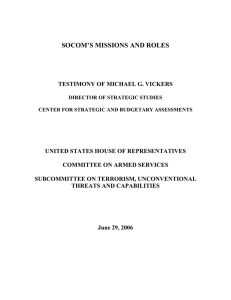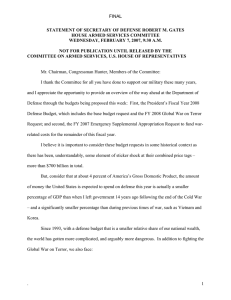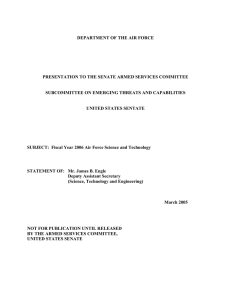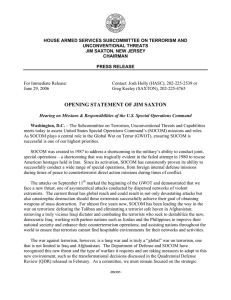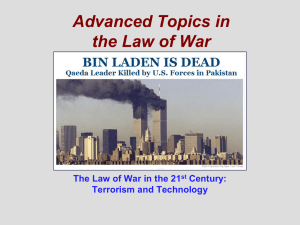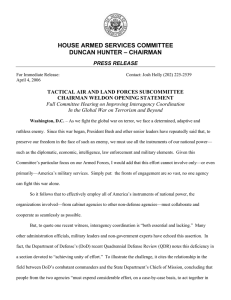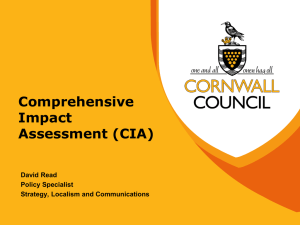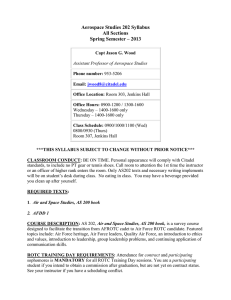IMPLEMENTING GWOT STRATEGY: OVERCOMING INTERAGENCY PROBLEMS
advertisement
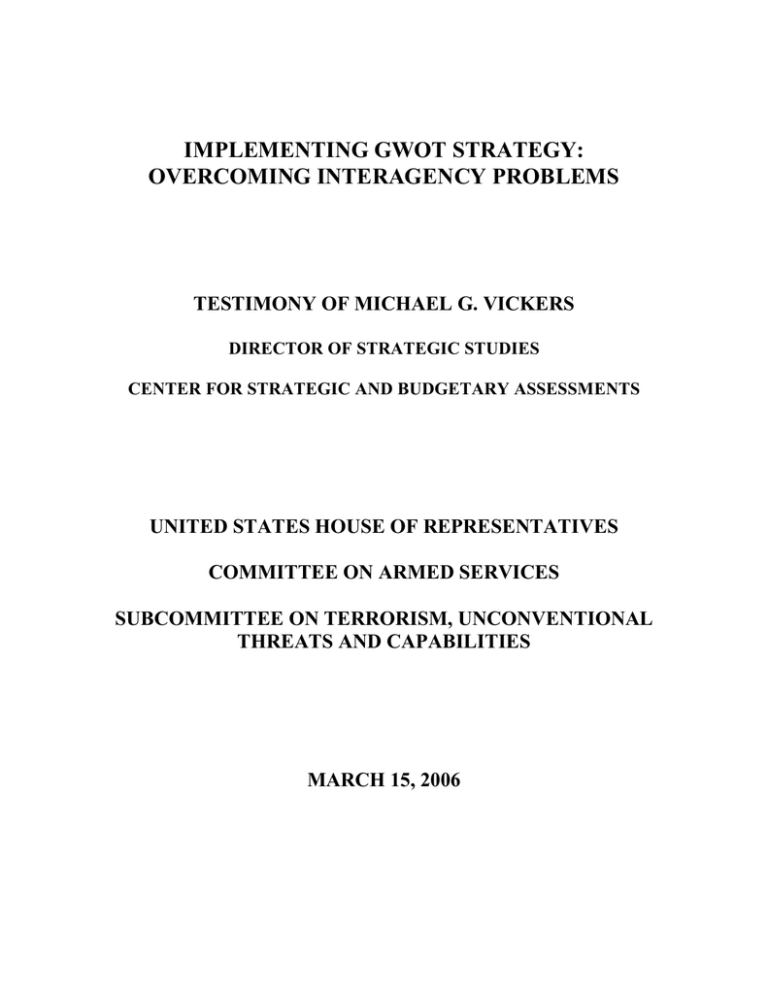
IMPLEMENTING GWOT STRATEGY: OVERCOMING INTERAGENCY PROBLEMS TESTIMONY OF MICHAEL G. VICKERS DIRECTOR OF STRATEGIC STUDIES CENTER FOR STRATEGIC AND BUDGETARY ASSESSMENTS UNITED STATES HOUSE OF REPRESENTATIVES COMMITTEE ON ARMED SERVICES SUBCOMMITTEE ON TERRORISM, UNCONVENTIONAL THREATS AND CAPABILITIES MARCH 15, 2006 Thank you, Mr. Chairman, for the opportunity to appear before you today, and to share my views with you on this important topic. I request that my prepared statement be made part of the record. My testimony contains five main points: · The Global War on Terrorism (GWOT) presents the U.S. national security establishment with its greatest organizational challenge since 1947. More than four years after the terrorist attacks of September 11, 2001, there remain significant organizational deficiencies within departments and agencies and across the national security establishment in both GWOT planning and execution. The current U.S. organizational approach is best described as general strategic direction and compartmented execution. This limits the effects we are able to achieve at the strategic, operational and tactical levels. The organization charged with national strategic and operational planning, the National Counter Terrorism Center (NCTC), lacks the authority and capabilities to fulfill its mandate. While there are numerous instances of integrated operations in the field, integrated strategy execution remains very much personality dependent. Military operations and capabilities that might be brought to bear are frequently denied interagency approval or country clearance. In other instances, restrictions are placed on their use such that they are rendered ineffectual. · Winning the GWOT will require new organizational capabilities across the national security establishment. If the early Cold War is any guide, it will require the creation of some new institutions as well. New organizational arrangements and processes are necessary, but not sufficient. Getting the right people in place to plan and execute the GWOT, moreover, is far more important than developing the right organizational arrangements. Selection for high operational command is a critical task for the senior leadership. Significant investments, moreover, will need to be made in national security education to train GWOT strategists across the national security establishment. There has been significant progress in creating new organizational capabilities for the GWOT since the attacks of September 11, 2001. The greatest progress has been made in the Department of Defense, particularly with regard to recent decisions to increase Special Operations Forces (SOF) capabilities and capacity as part of the 2005 Quadrennial Defense Review, and in the Central Intelligence Agency, with its expansion of its Operations Officer ranks. Secretary Rice’s Transformational Diplomacy Initiative also holds significant promise. Much remains to be done, however. The greatest deficiencies lie in the lack of U.S. Government capabilities to effectively counter Islamist ideology, the lack of a true National Clandestine Service, and the lack of effective organizational mechanisms to integrate strategic and operational planning and execution. · The dominant future form of the GWOT will likely be a protracted, indirect and clandestine fight in scores countries with which the US is not at war. The GWOT is an intelligence and special operations-intensive war. Getting this aspect of 2 interagency organization right, and making full use of special authorities to wage the indirect and clandestine fight, is imperative. Particularly important in this regard is leveraging the CIA’s Title 50 authority for SOF operations through flexible detailing of SOF personnel to the Agency. · Operations in the GWOT primarily occur at the country and sub-region level. Strategy is most effectively made at these levels, as well as at the global level. Our system of high command across departments and agencies is focused on the regional level, which is of reduced importance in both GWOT strategy and operations. In short, our interagency command structure is not well aligned with the geographic realities of the GWOT. GWOT operational areas should be established at the country and sub-region level. Sub-regional task forces are needed to conduct integrated area surveillance and cross-border operations. DoD senior counterterrorism presence is in need of significant elevation at the Country Team level, particularly in countries with which the US is not at war. Standing Interagency Task Forces commanded by either a military officer or CIA officer, as operational circumstances dictate, should be established as the execution arm for the designated operational areas. · Unity of effort must be achieved in both GWOT planning and execution, at the strategic, operational and tactical levels. This will require substantially strengthening the NCTC. The NCTC should become a subordinate national strategic and operational planning arm of the NSC. Clandestine operations and covert action will likely be key instruments in GWOT execution. It is imperative that we have an integrated structure in these areas, and develop a true National Clandestine Service. Current Organizational Shortfalls To summarize the current GWOT system for strategy formulation, responsibility for national strategy on the overseas, forward offense side is the province of the National Security Council (NSC). The Homeland Security Council has equivalent responsibility on the domestic, defensive side. Responsibility for national strategic and operational planning has been assigned to the National Counter Terrorism Center (NCTC). National military strategy for the GWOT is the responsibility of the Joint Staff (Strategy, Plans and Policy Directorate). Responsibility for the Global GWOT campaign plan is vested in U.S. Special Operations Command (SOCOM). Responsibility for theater GWOT strategy is the responsibility of the Geographic Combatant Commanders (GCCs). Within the CIA, the Counter Terrorism Center is responsible for global GWOT strategy and operations, with the Area Divisions in the lead or in support as circumstances dictate. At the Department of State, the Ambassador for Combatting Terrorism is responsible for global CT strategy, and the Regional Bureaus are responsible for integrated regional strategy. The Department of Homeland Security is responsible for homeland security strategy, and the Department of Defense responsible for homeland defense strategy. While it is essential to have an integrated foreign-domestic, offense-defense strategy for the GWOT, the remainder of my testimony deals principally with the interagency aspects 3 of the overseas, forward offense side. The principal operational elements (strategy execution) for the overseas aspects of the GWOT are the Departments of State and Defense, and the CIA. The FBI and Treasury also play important roles. There are significant organizational deficiencies within departments and agencies and across the U.S. national security establishment in both GWOT planning and execution. The current U.S. organizational approach is best described as general strategic direction and compartmented execution. This limits the effects we are able to achieve at the strategic, operational and tactical levels. In planning, the problems center on the NCTC and SOCOM, the two organizations charged with national and military global strategic planning and operations. The NCTC may be charged with national strategic and operational planning, but has limited authority and capability to do so. It is an Intelligence Community, primarily terrorist warning organization that has been charged with integrated strategic and operational planning for diplomacy, information influence operations, covert action and military operations. Responsibility for integrated national planning is thus divorced not only from execution, but, for all practical purposes, from detailed operational planning as well. A similar problem besets SOCOM. It has been charged with developing detailed global military plans, but it is isolated from non-DoD planners (the Joint Staff, for example, represents DoD on the NCTC). SOCOM’s global planning authority is also circumscribed, for all practical purposes, within DoD by the power wielded by the GCCs. While there are numerous instances of interagency cooperation in strategy execution in the field, cooperation and integrated strategy and operations remain very much personality dependent. Many of the same frictions that exist in planning (between SOCOM and the GCCs, for example) also exist with regard to the execution of strategy. In addition, within DoD, there is compartmentation and non-integrated operations between the Black and White sides of SOF, and beyond DoD, there is compartmentation and non-integrated operations between CIA and DoD. There is, moreover, as of yet no higher command within SOF for the planning and execution of global unconventional warfare (UW) that is equivalent to that which exists on the counterterrorism side. Our ability to integrate the strategy and operations of our allies and partners, which are an essential element of an integrated Global Counter Terrorism Network, remains limited. Organizational Imperatives and Options The fundamental GWOT organizational challenge is twofold: achieving unity of effort and effective operational command across instruments of national and international power, and developing the capabilities across the U.S. national security establishment that are needed to implement the strategy. Developing the required capabilities will in turn depend critically upon the resolution of a number of roles and missions issues across the U.S. national security establishment. These capabilities must be suited for the likely principal future operational environment of the GWOT: simultaneous operations in scores of countries with which the US is not at war. GWOT integrated command structures must reflect an appropriate interagency division of labor, depending on the 4 operational circumstances involved, and result in an effective span of control for planning and execution. The Importance of Organizational Capabilities The effective employment of all instruments of national power depends as much on possessing the required organizational capabilities as it does on developing appropriate organizational structure and processes. There has been significant progress in creating organizational capabilities for the GWOT since the terrorist attacks of September 11, 2001, but much remains to be done. The GWOT, moreover, poses significant roles and missions issues within the Department of Defense and across the broader U.S. national security establishment—in homeland defense, clandestine human intelligence and covert action, stabilization and reconstruction operations, and information influence operations, for example—that are in need of resolution. Since the terrorist attacks of September 11, the planning capacity of the Department of Defense for the GWOT has been significantly bolstered. SOCOM has been designated as the supported command to plan, synchronize, and, when directed, execute GWOT strategy and operations. SOCOM has stood up the Center for Special Operations (CSO) to fulfill its GWOT planning responsibilities. The Theater Special Operations Commands (TSOCs) – the special operations component of the GCCs -- have received significant augmentation to make them more capable of 24/7, long-duration GWOT operations. The command and staff elements of the Joint Special Operations Command (JSOC) have likewise been strengthened for long-duration operations. The 2005 QDR produced a number of important decisions with respect to SOF operational capabilities, capacity, and posture. The number of active duty Special Forces (SF) battalions, which are essential for low visibility persistent presence, low-level intelligence collection, building the capacity of partners, and conducting unconventional warfare, will be increased by 33 percent. Special Mission Unit (SMU) squadrons will be increased by an equivalent amount. DoD’s investment in tagging, tracking and locating (TTL) capabilities will be increased substantially. New investments will also be made in clandestine air mobility and persistent airborne surveillance. The CIA’s Directorate of Operations (DO) has embarked on a major increase in capacity as well. The size and shape of the Clandestine Service that was sufficient to win the Cold War is wholly inappropriate for the GWOT. The Department of State is shifting diplomatic personnel to support GWOT priorities in accordance with Secretary Rice’s Transformational Diplomacy Initiative. The Department has also stood up an office to support stability and reconstruction operations, though its current capabilities are very limited. To what extent DoD should get into the clandestine operations business and how much of the burden of stability and reconstruction operations DOS can be relied upon to shoulder in the future remain unresolved, however. The biggest capabilities shortfall across the interagency at present is in the area of countering radical Islamist ideology. The US has nothing comparable to the capabilities 5 it fielded to counter the threat of world communism early in the Cold War. Both covert and overt capabilities will be required. The capabilities required are by no means confined to public diplomacy. What the division of labor in this area should be among DOS, CIA, DoD, and perhaps new organizational entities, is yet to be determined. The Future GWOT Battlespace: Countries with which the US is not at War A key GWOT objective is to keep radical Islamists from regaining state sanctuary. To the extent that we succeed, the principal GWOT battleground will occur in states with which the US is not at war, and the principal fight will be an indirect and low visibility/clandestine one from a U.S. perspective. This poses a number of challenges for the effective integration of all elements of national and international power. In addition to the planning frictions and compartmentation problems noted above, there is also the issue of to what extent the U.S. armed forces will be engaged in this fight. In countries with which the US is not at war, DOS and CIA dominate. As a result, military capabilities that might be brought to bear have been denied country clearance, or have had their operational freedom severely restricted if clearance is granted. The current interagency system for operations in countries with which the US is not at war too often defaults to pre-9/11 modes of thinking and ways of operating, and in any event is very much dependent on the risk profile and policy priorities of U.S. Chiefs of Mission and Station. Determining the extent to which U.S. military capabilities will be brought to bear in these countries and which organization will own them is imperative. The GWOT is an intelligence and special operations-intensive war. Getting this aspect of interagency organization right, and making full use of special authorities to wage the indirect and clandestine fight, is essential. There is probably no more important single action the U.S. Government can take to improve strategy and operations in the GWOT than this. This would entail integrating CIA capabilities with those of Black and White SOF. It would also entail regularly leveraging the CIA’s Title 50 authority for SOF operations through the flexible detailing of SOF personnel to the Agency. This can begin with JSOC, which currently enjoys the closest relationship with the Agency, and then be extended to the Special Forces and SEALs. Aligning Operational Command with GWOT Operational Areas Integrated GWOT strategy must be planned and executed at the global, subregional and country levels. GWOT operations occur principally at the country and subregion levels. DoD is underrepresented in most countries. Sub-regional task forces remain the exception rather than the rule. Command structure and organization across the U.S. national security establishment should reflect the geographic reality of the GWOT. A first step toward effective command would include the designation of GWOT operational areas, followed by the establishment of standing CIA-DoD organizations aligned with these areas. GWOT operational areas would be both country-specific and sub-regional. Achieving unity of effort across sub-regions would permit more effective 6 use of airborne and maritime surveillance platforms, and enable expanded unconventional warfare operations against trans-national terrorists. There are a number of areas of the world – Pakistan-Afghanistan, for example – where an integrated subregional approach to operations is vital. CIA-DoD Interagency Task Forces aligned with key sub-regions could be commanded by a military officer or a CIA officer, depending on the dominant character of operations involved. The senior Chief of Station in a subregion could be dual-hatted as an IATF commander. Operational command of IATF components should generally be in the hands of a military or CIA officer, as appropriate, though cross-organizational teams should be established when operational circumstances dictate. Achieving Unity of Effort: Lead Agency versus Integrated Organization Two basic organizational models exist for achieving interagency unity of effort: designating one department or agency as the lead agency for the mission (analogous, though not entirely so, to the concept of supported commander in the military system of high command), or establishing an integrated organization. Prior to the 9/11 attacks, the Department of State was frequently designated as the lead agency for overseas counterterrorism, and the Department of Justice was so designated for domestic counterterrorism. This model may have been appropriate when radical Islamist terrorism was seen as principally a diplomatic and law enforcement problem, but it is no longer suited to the war in which we find ourselves. In combat zones, the military is the dominant actor. But, as noted above, GWOT operations in combat zones will likely be the exception rather than the rule for the Long War. Covert action is the exclusive purview of the CIA. Designating the CIA as the lead agency works very well when covert action is the exclusive execution arm of policy, as it was, for example, during American support for the Afghan resistance during the 1980s. But while covert action is an essential tool of the GWOT, more than that instrument will need to be brought to bear to implement strategy. Some have suggested extending the lead agency concept to GWOT lines of operation. Under such a scheme, the Department of Homeland Security might be designated the lead agency for defending the homeland, with the Department of Defense designated the lead for disrupting and attacking terrorist organizations, and the Department of State for countering extremist ideology. There are several problems with this idea, however. First, in most countries of the world, the CIA is far more heavily involved in disrupting and attacking terrorist organizations than is the Department of Defense. Second, it is not clear that the Department of State is organizationally suited to the mission of countering extremist ideology using all instruments of national power. Third, a more flexible approach might better serve U.S. interests in which DoD would be the lead agency for disrupting and attacking terrorist organizations in some areas, while CIA would be in others. Fourth, integrated organizations will almost certainly be more effective at bringing to bear a fuller range of national and international capabilities than organizations dominated by one department or agency. Fifth, the GWOT requires integrated national and international planning, both globally and locally. 7 What would appear to make most sense in the GWOT planning realm would be to vastly strengthen the NCTC’s capabilities in terms of strategic and operational planning, and to separate it from the Intelligence Community and place it under the NSC. Strengthening its strategic and operational planning capabilities would require that substantial planning resources be transferred to it from SOCOM, the CIA’s Counter Terrorism Center and the State Department’s Office of Combatting Terrorism. Other organizations with operational responsibilities (Treasury and whatever entity emerges as the lead operational agency for the war of ideas) would also need to be included. It is by no means clear, however, that an NCTC-like organization capable of integrated strategic and operational planning need be replicated at the regional level. What would appear to make most sense in terms of GWOT execution would be to bolster DoD’s presence at the Country Team level, particularly for countries with which the US is not at war, and establish standing CIA-DoD interagency operational task forces at the country and subregion levels, led, as noted above, by either a military officer or a CIA officer, who could be dual-hatted as a COS, as operational circumstances dictate. Given the indirect character of our strategy, integration at the interagency level must also be extended to our allies and partners. Operational compartmentation will still be required to protect sources and methods. Planning, however, should be integrated at the level of effects. Operations at the tactical level should be integrated as the tradeoff between additional capabilities and the need for compartmentation dictates. Getting the right people in place to plan and execute the GWOT is far more important than developing the right organizational arrangements. Selection for high operational command is a critical task for the senior leadership. Significant investments, moreover, will need to be made in national security education to train GWOT strategists across the national security establishment. A three-star, global UW command should be established within SOCOM. Such a command would do for the global execution of UW (against both state and trans-national actors) what JSOC does in the area of counterterrorism and counterproliferation operations. A SOF UW command would complement, not supplant, the CIA. Covert action, which was conducted episodically during the Cold War, must be conducted continuously for the GWOT if we are to prevent future terrorist attacks on our homeland. Moving toward a true National Clandestine Service is an essential GWOT reform. Our experience in the early Cold War shows clearly the disadvantages of maintaining separate clandestine services. DoD personnel, particularly those from SOF, should play a much larger role in the NCS. This should include the ability to compete for COS positions. 8
